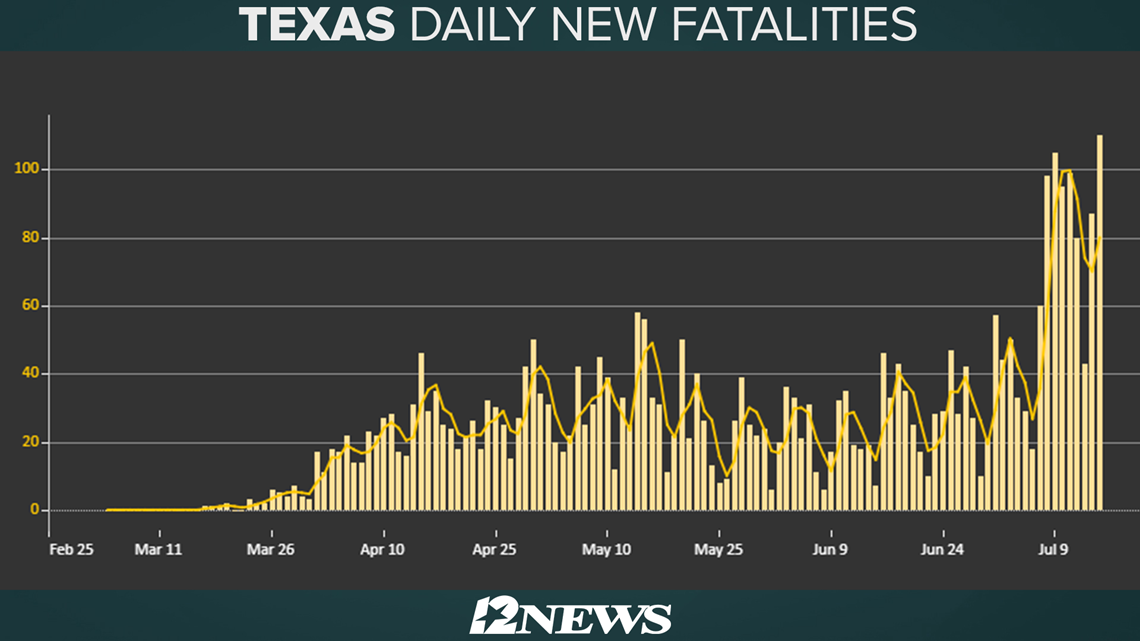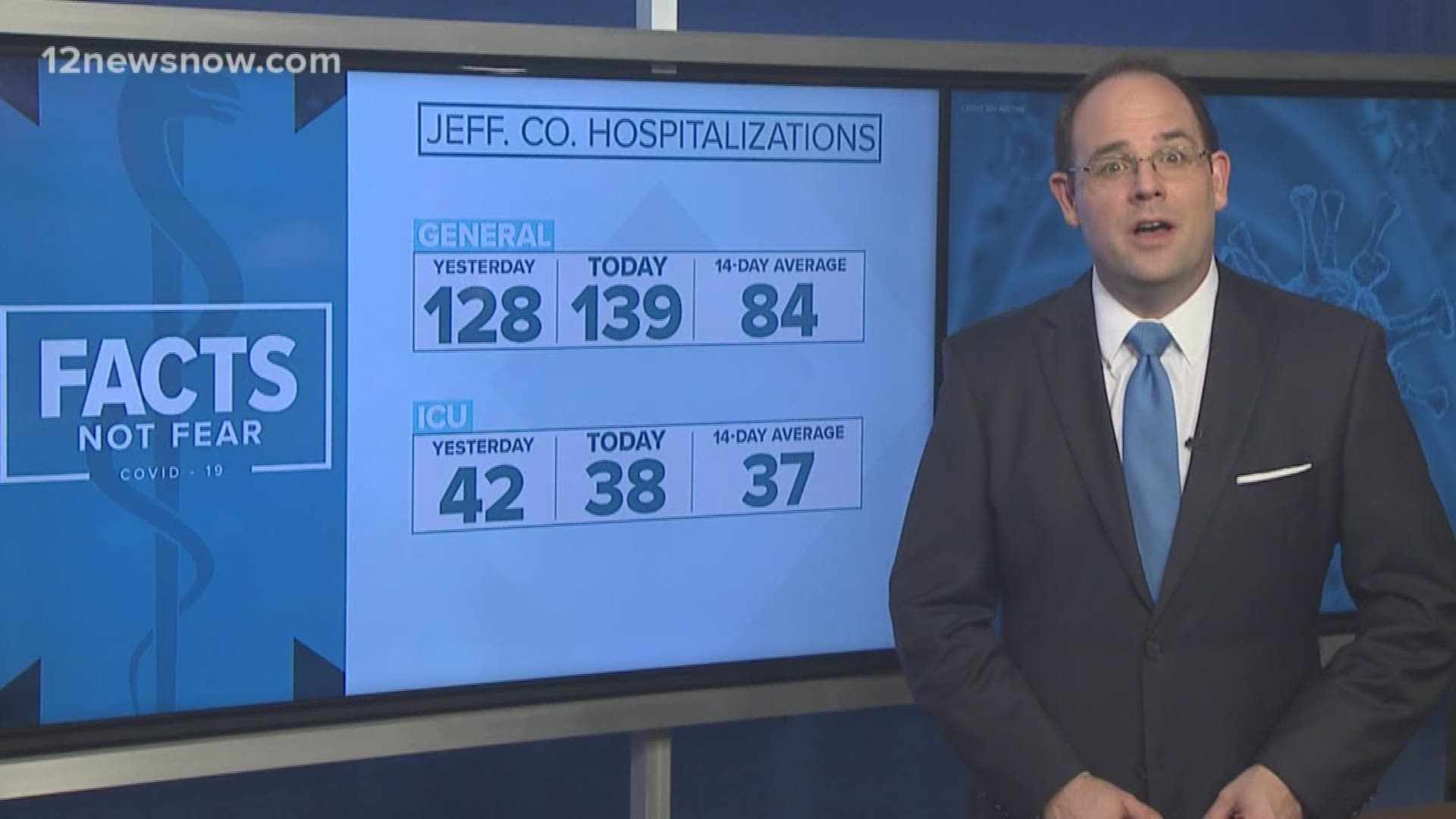BEAUMONT, Texas — COVID-19 fatalities have steadily ticked up across Texas and the state has reached a fever pitch. Halfway through July, we have already seen 1,137 Texans die from the virus. In all of June, 752 people died from the virus.
Texas reported a single-day high of 129 COVID-19 deaths Thursday.
Deaths tend to lag new cases because it can take weeks for a patient to get sick enough to be hospitalized and eventually die, according to the Kaiser Family Foundation.
Data from the Texas Department of Health and Human Services show deaths reaching historic highs in July. Texas recorded the highest number of deaths in a single day on July 16 when 129 Texans died from the virus. 110 deaths on July 15 was the previous record.
Daily fatalities reported by the state rarely went above 50 until July. In June the average daily death toll was 25. It's now more than doubled in the first half of July.


3,432 Texans have died from COVID-19 since the pandemic began. Dallas County has seen the most lives lost -- with 477 deaths. Harris County follows a close second with 473 deaths.
Texas Deaths by County (as of 7/15/20)
- Dallas Co.: 477
- Harris Co.: 473
- Tarrant Co.: 272
- Bexar Co.: 201
- Travis Co.: 179
- El Paso Co.: 159
- Hidalgo Co.: 152
- Cameron Co.: 79
- Fort Bend Co.: 65
- Nueces Co.: 64
Jefferson County has seen 43 residents killed by coronavirus. Orange, Chambers and Hardin County have reported five fatalities.
There have been fatalities reported in 147 of Texas' 254 counties, according to stats released by DSHS.
The data on fatalities is not perfect, epidemiologists say. If a patient with an underlying health problem such as heart disease dies while also testing positive for COVID-19, doctors can categorize the death as either.
And there are also elderly patients in care facilities who die and are often never tested for the virus. Likewise, people with underlying health conditions who aren't tested for coronavirus aren't included in totals.
WHO'S DYING FROM COVID-19?
The largest study of its kind analyzing deaths linked to COVID-19 shows that older people, men, minorities and those with underlying health conditions are among the most vulnerable. The study based in England was published in the research journal Nature.
In Texas, the state has only released stats on 728 of the state's 3,432 deaths.
Of the stats released by DSHS, the most deaths have been from those 80 years and older. 285 Texans over the age of 80 have died.
There have been no deaths reported in anyone under the age of 19 in Texas, according to DSHS.
Deaths by Age in Texas (as of July 15):
- <1: 0
- 1-9: 0
- 10-19: 0
- 20-29: 4
- 30-39: 12
- 40-49: 28
- 50-59: 77
- 60-64: 74
- 65-69: 84
- 70-74: 79
- 75-79: 85
- 80+: 285
DSHS says 59% of deaths have been male. 43% have been White, 29% Hispanic and 13% Black.
Coronavirus symptoms
The symptoms of coronavirus can be similar to the flu or a bad cold. Symptoms include a fever, cough and shortness of breath, according to the Centers for Disease Control.
Most healthy people will have mild symptoms. A study of more than 72,000 patients by the Centers for Disease Control in China showed 80 percent of the cases there were mild.
But infections can cause pneumonia, severe acute respiratory syndrome, kidney failure and even death, according to the World Health Organization. Older people with underlying health conditions are most at risk.
The CDC believes symptoms may appear anywhere from two to 14 days after being exposed.
RELATED: VERIFY: No, members of Congress who are self-quarantined for coronavirus cannot vote remotely
Human coronaviruses are usually spread through...
- The air by coughing or sneezing
- Close personal contact, such as touching or shaking hands
- Touching an object or surface with the virus on it, then touching your mouth, nose or eyes before washing your hands.
Help stop the spread of coronavirus
- Stay home when you are sick.
- Eat and sleep separately from your family members
- Use different utensils and dishes
- Cover your cough or sneeze with your arm, not your hand.
- If you use a tissue, throw it in the trash
Lower your risk
- Wash your hands often with soap and water for at least 20 seconds. If soap and water are not available, use an alcohol-based hand sanitizer.
- Avoid touching your eyes, nose, and mouth with unwashed hands.
- Avoid close contact with people who are sick.
- Clean and disinfect frequently touched objects and surfaces.
- If you are 60 or over and have an underlying health condition such as cardiovascular disease, diabetes or respiratory illnesses like asthma or COPD, the World Health Organization advises you to try to avoid crowds or places where you might interact with people who are sick.

